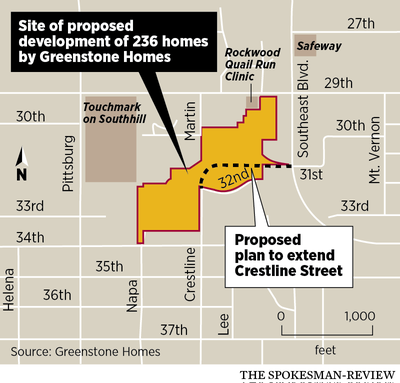South Hill development showdown rests with City Council

A road must run through the center of a proposed “walkable mixed-use urban neighborhood” on Spokane’s South Hill, according to a decision by the county’s hearing examiner.
Both the developer of the project and neighbors oppose the ruling.
The project by Greenstone Homes will build 236 homes on 25 acres of forested land near the intersection of 29th Avenue and Southeast Boulevard, and has been described as akin to Kendall Yards, the fast-growing development across the Spokane River gorge from downtown.
In his decision, David Hubert, the hearing examiner, said the project must extend Crestline Street through the development to comply with the city’s long-term comprehensive plan, which guides development in the city.
This argument is supported by city traffic engineers, who say the comprehensive plan and municipal code require the extension of Crestline and “prudent engineering practices indicate the need for the extension,” according to the examiner’s decision.
Greenstone, which is behind both the South Hill project and Kendall Yards, has appealed Hubert’s decision. A second appeal came from 58 people living in the area, and is supported by the Lincoln Heights Neighborhood Council.
Both appeals said the road extension would create more traffic in the neighborhood, damage its character, decrease its aesthetic value and make it less safe.
The matter now heads to the City Council, which will have the final say about the road. A vote has not yet been scheduled, but in June the council unanimously supported a resolution removing the Crestline extension from the comprehensive plan. Councilman Mike Fagan, the council’s lone conservative, was absent for the vote.
The disagreement over the road comes down to a simple question: Will a new road ease traffic problems on the South Hill, or will it make them worse?
Under Greenstone’s plan for the Garden District, upward of 236 residential units and 38,000 square feet of office, retail and commercial space will be built on the land that is still largely covered in trees, shrubs and grasses. The property, which sits southwest of the intersection of 29th and Southeast Boulevard, is an old dairy and tree farm that has been owned for decades by the Sonneland family, which long planned to develop it.
According to its appeal, Greenstone said the road would “eliminate open space and cause the loss of urban forest.” It also points to what it characterizes as an inconsistency between the hearing examiner’s decision and a recommendation made by the city’s Design Review Board, which reviewed and approved of Greenstone’s application for the development without the extension of Crestline.
The Design Review Board “explicitly approved the site plan without the extension of Crestline, despite staff’s recommendation that Crestline be extended,” the appeal reads, noting that the review board “imposed conditions to preserve open space and the mature trees, which cannot be satisfied if the extension of Crestline is required.”
Jim Frank, founder of Greenstone, said in an email that building a road to ease traffic congestion caused by the increase in residents and businesses was wrongheaded.
“I find it interesting that many other cities have come to the conclusion that you can’t solve traffic problems by building more or bigger roads. The answer lies in better land planning and diverse transportation options,” he wrote. “The City staff is just not there yet. We hope the appeal opens the door to a broader based and sustainable transportation plan.”
The neighborhood’s appeal against the road extension is largely focused on what it describes as Hubert’s “erroneous legal conclusions.” It says the road extension would harm the neighborhood by destroying “important trees and urban canopy” and increase traffic near Hamblen Elementary School, “strongly” increasing the “likelihood that a young child will be hit or struck by a car.”
It also pointed out that the comprehensive plan “explicitly” rejects building major roads through neighborhoods. The plan says that “principal arterials that bisect neighborhoods create undesirable barriers to pedestrian circulation and adversely impact adjoining residences. Whenever possible, principal arterials should be located on the outer edge of neighborhoods.”
In its opposition to the road extension, the neighborhood council focused on safety concerns, saying the road would cause “an increase of volume and speed of traffic on Crestline” and the pedestrians and children walking to Hamblen would be “endangered by the Crestline extension because of the lack of sidewalks and increased traffic.”
All of this runs afoul of the city planning department, which issued a report in December ahead of the hearing examiner’s hearing. It said the road extension was necessary to avoid gridlock.
“While there is network capacity on the arterial system surrounding this development, there is no direct access from the main residential portion of this development to the arterial network,” read the report. “Therefore, the Crestline to Southeast Boulevard connection is vital to providing this access.”
Council President Ben Stuckart would not comment on the matter, but said the vote would be soon.
“Definitely in the next couple of months,” he said. “The City Council is the final arbiter acting in a quasi-judicial manner, not as a legislator.”
The decision was made by Hubert because the city’s examiner, Brian McGinn, recused himself to avoid a perceived conflict. Before joining the city, McGinn had worked with the lawyer representing Greenstone.